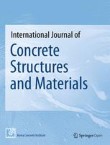International Journal of Concrete Structures and Materials is affiliated with Korea Concrete Institute.
Strength Prediction of Corbels Using Strut-and-Tie Model Analysis
A strut-and-tie based method intended for determining the load-carrying capacity of reinforced concrete (RC) corbels is presented in this paper. In addition to the normal strut-and-tie force equilibrium requir...
